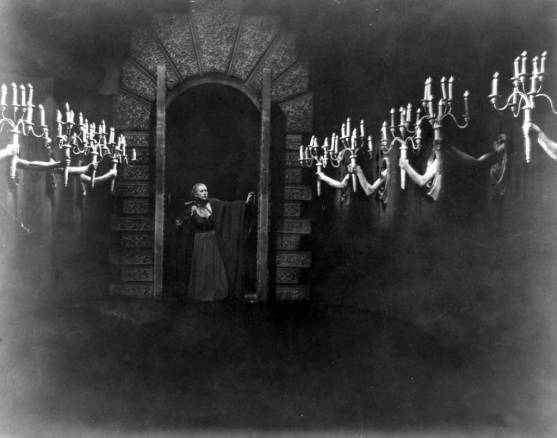 |
| Fig. 1: Original Theatrical Poster |
The tale of the beauty and the beast is arguably known by most through Disney's 1991 adaption, which to this day, holds its place as the most beloved version of the story. Jean Cocteau's 1946 adaption goes back to a time before computer effects and modern cinematic make-up, and shows the magic that could still be created without features we now take for granted. "Here is a fantasy alive with trick shots and astonishing effects, giving us a Beast who is lonely like a man and misunderstood like an animal. Cocteau, a poet and surrealist, was not making a "children's film" but was adapting a classic French tale that he felt had a special message after the suffering of World War II: Anyone who has an unhappy childhood may grow up to be a Beast." (Ebert, 1999)
By far the most extraordinary feature in the film is the Beast's castle, with rose gardens, overgrown plants, statues, extravagant bedrooms and a dining room in which all the candelabra's are held by human hands (fig. 2). The eyes of the statues in the dining room follow the characters, observing, while hands from the table pour wine for Belle, and earlier her father -- it is clear from this where Disney drew inspiration for the servant characters in the 1991 film, who are all trapped in household objects, perhaps Cocteau was showing the same thing. The castle is its own world, and completely different from the one Belle knew; "the visual progression of the fable into a dream-world casts its unpredictable spell." (Crowther, 1947). The castle could be representative of The Beast; it is monstrous to look at, overgrown, broken in places, yet somehow still beautiful and mysterious. The use of human hands being part of the castle shows the conflict between the man and the beast; small glimpses of humanity within a monster.
 |
| Fig. 2: Hands hold sconces from the walls. |
 |
| Fig. 3 The Beast meets Belle at dinner. |
Some critics have argued that the scene where Belle and The Beast first meet has underlying erotic tones; "Before she has even seen him, she is aroused to her very depths... she toys with a knife that is more than a knife." (Ebert, 1999), "There is an obvious undercurrent of eroticism here, too. This is acknowledged finally when Beauty (Josette Day) tells the Beast (Jean Marais) "I like being afraid... with you." (Macnab, 2014). However, these modern reviews emphasise modern attitudes, they are imposing more recent concepts of underlying erotic sexuality to the film. In doing so they fail to analyse objectively. While the beast is often depicted as dominant -- often standing above belle -- to presume that this is sexual is somewhat misogynistic. As far as Belle is concerned, she is now hostage to a beast that threatened to kill her father, and is more likely concerned with what The Beast's intentions are with her. Even members of the audience will be wondering this.
While La Belle et la Bête may have once been considered a classic, it has been overshadowed by Disney's adaption, which has more appeal to modern audiences and is enjoyable for all ages. Cocteau's film is stunning in its own right, but as more and more new versions of the tale emerge, it only becomes more buried. While the 2014 remake of the film (fig. 4) was not as successful as the original, there will no doubt be another attempt in years to come.
 |
| Fig. 4: La Belle et la Bête 2014 remake. |
Images:
Figure 1. Original Theatrical Poster (1946) [poster] At: http://theredlist.com/wiki-2-24-224-267-view-fiction-profile-beauty-and-the-beast.html (Accessed on: 02.12.15)
Figure 2. Hands hold sconces from the walls. From: La Belle et la Bête. Directed by: Jean Cocteau [Film still] France: DisCina. At: http://mediartinnovation.com/2014/08/11/jean-cocteau-mythopoeic-movies-la-belle-et-la-bete-1946/ (Accessed on 19.12.15)
Figure 3. The Beast meets Belle at dinner. From: La Belle et la Bête. Directed by: Jean Cocteau [Film still] France: DisCina. At: http://theredlist.com/wiki-2-24-224-267-view-fiction-profile-beauty-and-the-beast.htm (Accessed on 17.12.15)
Figure 4. La Belle et la Bête 2014 remake. [poster] At: http://www.bleedingcool.com/2013/09/28/first-poster-for-la-belle-et-la-bete-starring-vincent-cassel-and-lea-seydoux/ (Accessed on: 19.12.15)
Figure 4. La Belle et la Bête 2014 remake. [poster] At: http://www.bleedingcool.com/2013/09/28/first-poster-for-la-belle-et-la-bete-starring-vincent-cassel-and-lea-seydoux/ (Accessed on: 19.12.15)
Bibliography:
Ebert, R. (1999) 'Beauty and the Beast'. In: rogerebert.com 26.12.1999. [online] At: http://www.rogerebert.com/reviews/great-movie-beauty-and-the-beast-1946 (Accessed on: 17.12.15)
Macnab, G. (2014) 'La Belle Et La Bete: Film review - Cocteau's Forties fantasy is still a thing of real beauty'. In: The Independent 02.01.14 [online] At: http://www.independent.co.uk/arts-entertainment/films/reviews/la-belle-et-la-bete-film-review-cocteaus-forties-fantasy-is-still-a-thing-of-real-beauty-9035506.html (Accessed on: 19.12.15)
Macnab, G. (2014) 'La Belle Et La Bete: Film review - Cocteau's Forties fantasy is still a thing of real beauty'. In: The Independent 02.01.14 [online] At: http://www.independent.co.uk/arts-entertainment/films/reviews/la-belle-et-la-bete-film-review-cocteaus-forties-fantasy-is-still-a-thing-of-real-beauty-9035506.html (Accessed on: 19.12.15)
Crowther, B. (1947) 'La Belle et la Bete (1946) THE SCREEN IN REVIEW'. In: The New York Times 24.12.1947 [online] At: http://www.nytimes.com/movie/review?res=9B03EFD71E3EEE3BBC4C51DFB467838C659EDE (Accessed on: 19.12.15)

No comments:
Post a Comment